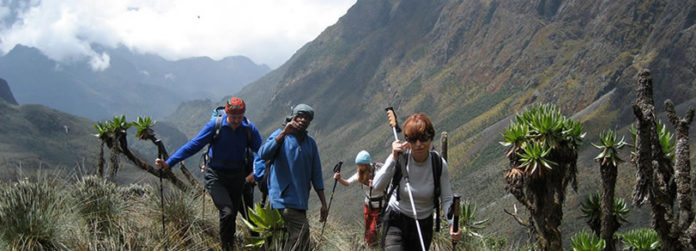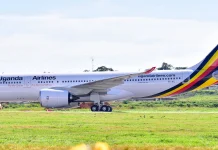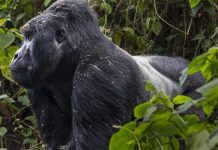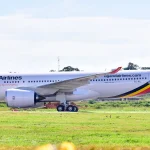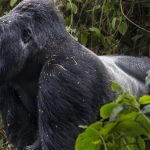The Rwenzori Mountain is the utmost mountain range in the whole of Africa, with 6 glacial peaks that include Mount Speke, Mount Stanley, Mount Gessi, Mount Emin Pasha, Mount Luigi da Savoia and Mount Baker. The main peaks can be feasibly compared to those of Kilimanjaro and Mount Kenya. These two peaks, Margherita (5.109m) and Alexandra (5.083m) on Mount Stanley are audacious for any adventurous mountain hiker in Africa. Rwenzori National Park located in the western part of Uganda on the border of Uganda and the Democratic Republic of Congo cover 998 sq km and was named after the famous Rwenzori Mountains which are also famously referred to as the ‘Mountains of the Moon’.
Rwenzori has unique glacial peaks able to be seen miles away as one travels in the Western part of Uganda. The Rwenzori Mountains offer spectacular landscape to the national park. The mountain slopes are above 1,600m and are a preserve of hikers, who rate the Rwenzoris to be the most challenging of all African mountains. Rwenzori has five various vegetation Zones and these are grassland include (1000-2000m), montane forest (2000-3000m), bamboo/ mimulopsis zone (2500-3500m), Heather/ Rapanea zone (3000-4000m) and the afro-alpine moorland zone (4000-4500m), which has forests of giants heather plants, giant lobelias and groundsels. The Rwenzori mountain vegetation is according to the altitude
Rwenzori Mammals
About 70 mammal species which consist of elephants, chimpanzees, golden cat, yellow-backed duiker, buffaloes, blue monkeys, Rwenzori colobus monkeys, forest hogs, hyrax and leopards plus many more have been recorded.
Rwenzori Birds
The park is gifted with over 177 bird species, these include the; Francolins, illadopsis, robin, Rwenzori turaco, apalis, owl, Archer’s ground robin, Olive Pigeon, cinnamon-chested bee-eater, White Necked Raven, barred long-tailed cuckoo, golden-winged sunbird, Lagden’s bush shrike and Mountain Buzzards plus many other endangered and widespread species which are rare elsewhere.
Rwenzori Tour Activities.
Safari activities at Rwenzori Mountains National Park include:
– Mountain hiking/Climbing tours
– Trekking safaris
– Wildlife tours
– Birding safaris
Visiting tourists are keen to take on the central circuit trail which cover 6 nights 7 days to complete and enables one to see the main peaks. Other shorter hikes can take up to 4 days. Generally, hiking is the well-known vacation activity to undertake in the park and it takes you via all the vegetation zones and leads you to the glacial peaks. Nevertheless, with hiking, the high peaks should be attempted by experienced mountaineers only, for safety reasons. Nature walks that expose one to various animal and bird species are also regularly liked by visitors.
Accommodation.
Kasese town, a close neighbour to Rwenzori has many affordable accommodation facilities of all classes of people. Rwenzori Mountaineering Service also offers accommodation facilities like huts with bunk beds along the central circuit.
Access to Rwenzori.
To get to Rwenzori Mountain National Park, you can either use road transport or air transport means. To reach the Park Headquarters at Nyakalegija, one can either travel to Fort Portal or Kasese, both in Western Uganda. Fort Portal, which is 300km from Kampala, can be reached via Mubende town. Total journey time is about 4hrs. Kasese, which is about 350km from Kampala, can be reached via Masaka, Mbarara and Bushenyi. The Kasese direction, although longer at 6hrs, is plausibly more exciting as it goes through the excellent Queen Elizabeth National Park, an optional pause in your trip. A chartered plane can properly be arranged by AAB Tours and Travel. By air, you land to Kasese airstrip from where you are able to move a short journey to the park.
Health and safety measures while mountaineering
The high attitude and the wet conditions of the Rwenzori and can deficiently affect visitors who are not experienced. Note that the following health problems are possible and you have to be prepared:
1. Hypothermia,
2. Dehydration,
3. Altitude sickness,
4. AMS (Acute Mountain Sickness)
5. HAPE (High altitude sickness pulmonary edema)
6. HACE (High altitude cerebral edema).
What you need for successful mountain hiking
Besides a high level of physical fitness, you ought to ensure that at least the following equipment are in your custody prior to hiking the Rwenzoris;
1. Hiking Boots, Gum boots: A strong set of hiking boots is essential, principally in the early stages of the climb and in the trek across the glaciers. Gum boots are vital equipment in the mud-covered sections of the mountain trail.
2. Rucksack: A powerful waterproof bag is necessary. Most times, Rwenzori can be wet. This will help maintain your essential items dry as you hike.
3. Cooking utensils: If you intend to do your own cooking, a light stove, some plates and cups should be in your possession. It is possible to hire a cook for the trip but still plan to have at least the bare essentials like the plates, cups, forks, knifes and others.
4. Warm stuff: After the first camp, the mountain gets much colder below 10°C and certainly below freezing at some camps. Good warm shirts and pants, a decent sleeping bag are all necessary. A good pair of warm waterproof gloves is necessary for whoever is hiking up to the peaks.
5. Emergency kits: Emergency medication is essential. For a large part of the expedition, you will be at least a day away from even the best emergency services.
6. Food: Most climbers carry their own food. Some food can also be bought at the Park Headquarters. You need energy giving food, glucose packs, sweetened juice mixers, chocolate and dry porridge mix are recommended. No need to carry water as the mountain provides lots of natural, sparkling, safe drinking water.
7. Equipment: All camps have huts but you may wish to carry a tent as it can improve trip flexibility and ensure to bring the common camping gears like the lighter, torch, toiletries, GPS to mention. However keep in mind that while you will have porters to help you out carry your equipment, there is a hard limit (22kg) as to how much each porter will carry: You therefore have to hire more porters if you have lots of kit.
The Park Headquarter has limited number of tents, rucksacks and boots for hire, be sure to speak to them before-hand to establish availability. Park offices also provides crampons, ice axes and ropes for hire, for those planning to try any of the peaks but you may bring your own. Warm objects can usually be bought in Kampala. Food and medicines can be acquired from any decent supermarket in Kampala or Kasese.
Rwenzori Mountain Climbing Tips
Arranging your Rwenzori trek is not significantly different from planning any other trip. Keeping in mind that trekking necessitates a large measure of constant physical energy for days up to the end where definite fundamental rules are relevant. One should also be reasonably fit, with good cardiovascular and respiratory performance.
Excellent information for Rwenzori Climbers
1. Be on familiar terms with your body: Don’t set your body through more pressure than it can handle. Once you tired, take a rest. Hiking should not be taken on like a competition. At higher altitudes especially from day 3 and beyond, watch out for signs of “Altitude Sickness” (brought on by low oxygen), which include shortness of breath, headache, loss of appetite. Harsh Altitude Sickness can be critical. Keep your guides informed of how you are feeling, so that they can give advice to you as a result. Do not assume your situation will automatically get better.
2. Safety First: Mountain rescue is a complex and dangerous undertaking. Certainly at camps like Kitandara, an evacuation will usually take two days and involves a host of porters and rangers.
3. Energy foods: Eating energy foods will greatly boost your experience as it will trim down exhaustion. Sugary snacks like chocolates, glucose biscuits and many more are generally very helpful all along the hike. Salty snacks like crackers help prevent muscle cramps.
4. Drink Lots of Water: Water is fine for you, principally at higher altitudes, where it helps reduce the effects of altitude illness. Clean drinking water is in plenty on the mountain from a number of springs.
5. Keep Warm: keeping warm will assist in good spirits as it prevents sickness. At higher altitudes, it is likely to fall with no notice: A warm pair of waterproof gloves is advised.
6. Interact With The Guides: Uganda Wildlife Authority has trained Park guides. Speak to your guides; ask questions as much as possible. The relationship you create with your guides, rangers and porters, the more they will share attention-grabbing insights.
7. Sunburn: look out for sun burn. Wear a top and if your skin colour calls for it, wear a sunscreen.
